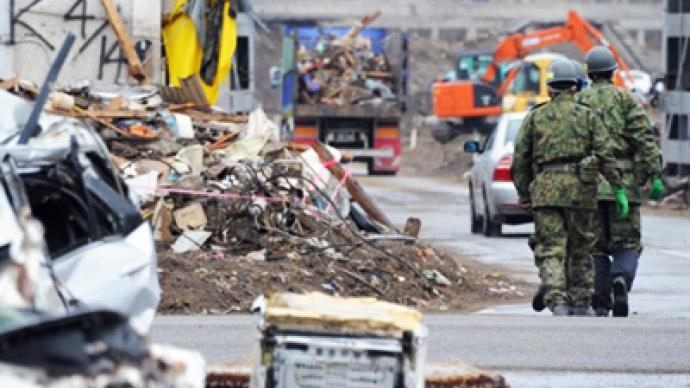The Fukushima Daiichi nuclear facility operator says it hopes to finish removal of radioactive debris from the plant’s territory by July. The company has already created a map showing the levels of radioactivity in different parts of the facility.
Tokyo Electric Power Co. announced on Sunday that highly radioactive debris is now lying on the territory of the plant, NHK television reports. Near Unit 3 of the facility they have found a concrete fragment which had a radioactivity level 900 millisieverts per hour. Now TEPCO is estimating a number of millisieverts in different part of the Fukushima plant in order to make the clean-up process safer. The company has been using remote-controlled machines to remove debris since April 6. The company said that it hopes to complete the clean-up by July, but has yet to decide on how to dispose of the removed debris. TEPCO is also due to construct more temporary storage tanks for highly radioactive water accumulated on the plant’s premises. This comes as part of the plan to pump out about 70,000 tonnes of water from turbine buildings and service tunnels. The company intends to move the contaminated water into a special nuclear waste processing facility at the plant and also temporary storage tanks. For this reason, TEPCO has plans to construct 31,400 tonnes of storage capacity by early June. The water is due to be sorted into three levels of contamination and stored accordingly.TEPCO also plans to install water filtration and cooling systems, designed to recycle the cooling water, to each reactor. There are also plans to add tanks with total capacity of 20,000 tonnes every month from June to December in case the systems cannot start operating in June. In order to store highly radioactive water, the company will build special underground tanks coated with material, resistant to radiation and corrosion. Fukushima Daiichi nuclear power plant survived a series of explosion and fires following March 11 earthquake and tsunami. The natural disasters have left over 26,000 missing or dead, NHK reports. The National Police Agency said that 14,294 have been confirmed dead after the disasters. This includes victims of aftershocks that hit the country on April 7 and 11. On Monday Japan’s Self-Defense Forces and the US military are due to start a third massive operation in search for about 12,000 missing people. The operation will last for two days and will cover coastal and inland areas and waters off Iwate, Miyagi, and Fukushima prefectures. The operation will also include land and water search within 30 kilometers from the troubled Fukushima plant, the area uncovered by previous missions.
Christopher Simons, professor of Literature at the International Christian University in Tokyo, says that though Japan is a prime candidate for green power, it is a very conservative and country which will be reluctant to give up its nuclear program quickly. And despite the fact that the Japanese are eco-friendly and can boast a variety of alternative energy sources, such as wind or tidal, the ties between the government and big business hinder any change in the country. Simons calls the crisis at Fukushima-1 the most complicated accident in history, even compared to the Chernobyl accident in 1986. Radiation contamination risks are high, believes Simons.“There’s certainly a risk of long-term exposure. In particular, the way in which we measure the radiation causes people to misunderstand. You have to take into account the density of radiation as well as the dose. It is possible there could be problems,” says Simons.
Jan Haverkamp, a nuclear power expert from Greenpeace, believes that the Fukushima-1 crisis is the beginning of the end of nuclear power.Haverkamp does not think that covering the reactors with a giant impenetrable dome to block radiation leaks is something easily done. “Let’s hope it can be done in six months or even earlier,” says Haverkamp. “But once the dome is over, the fuel needs to be removed, which is a very complex operation, and even then radioactivity could come out again.”Haverkamp criticized the ties between Japan’s government and the company operating the nuclear plant at Fukushima-1, as they resulted in the government overlooking several serious issues, which ultimately led to the catastrophe.

